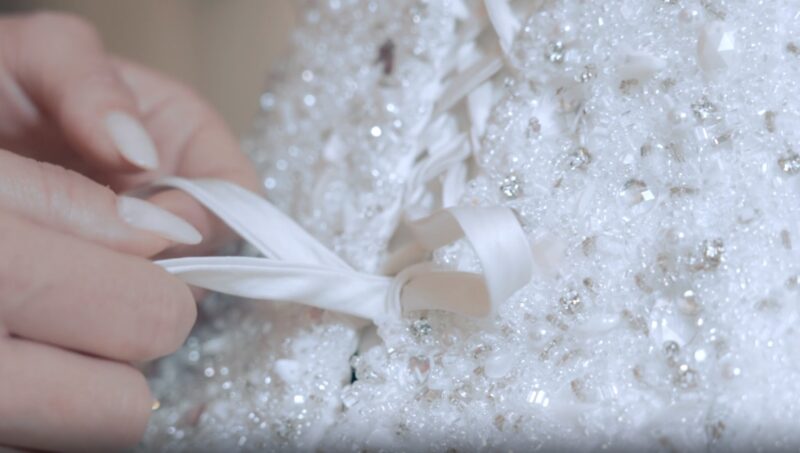Effective communication between the bride and the seamstress or tailor is crucial throughout the alteration process. It’s important for the bride to articulate her vision and expectations clearly. She should feel comfortable speaking up if something does not look or feel right during the fittings.
The seamstress or tailor can only make the desired adjustments if they fully understand the bride’s needs. Regular collaboration and open dialogue ensure the final dress aligns with the bride’s vision while also fitting comfortably.
Choosing the Right Professional for Alterations

Selecting the right professional for wedding dress alterations is a critical decision. It’s advisable to choose someone with experience in bridal gowns, as they differ significantly from regular clothing in terms of fabrics, construction, and detailing.
Recommendations from friends, family, or the bridal salon where the dress was purchased can be invaluable. It’s also important to consider the seamstress’s or tailor’s workload and whether they can dedicate the required time to the dress.
When meeting with potential professionals, discussing their experience, looking at their previous work, and understanding their alteration process is essential. This meeting is also the time to discuss the timeline and get an estimate of how long the alterations will take.
Cost Considerations in Wedding Dress Alterations

The cost of altering a wedding dress can vary greatly depending on the complexity of the work needed and the professional’s expertise. Simple alterations like hemming or taking in a dress might be relatively inexpensive, while more extensive modifications can be quite costly. It’s important to budget for these costs early in the wedding planning process.
In some cases, bridal salons offer alteration services, sometimes included in the price of the dress or at a discounted rate. However, it’s always a good idea to compare prices and services of different professionals to ensure getting the best service for the best price.
Preparing for the Final Fitting

The final fitting is a pivotal moment in the alteration process. This is when the bride sees her wedding dress in its final form, perfectly tailored to her body. It’s important to pay close attention to every detail during this fitting. The bride should move around in the dress to ensure comfort and ease of movement. She should also inspect the dress for any unfinished areas or details that might need last-minute adjustments.
After the Alterations: Care and Storage

Once the alterations are complete, the next step is properly caring for and storing the wedding dress until the big day. The dress should be stored in a breathable garment bag in a cool, dry place. It’s important to keep it away from direct sunlight and moisture to prevent any damage or discoloration.
In the days leading up to the wedding, the bride should also plan for transportation of the dress to the wedding venue. Ensuring the dress remains wrinkle-free and in pristine condition is crucial.
FAQs
How can I tell if a seamstress or tailor is skilled in wedding dress alterations?
To assess the skill level of a seamstress or tailor in wedding dress alterations, ask for a portfolio of their previous work, specifically with bridal gowns. Look for a range of styles and complexities in their work.
Also, ask for references from previous brides and inquire about their satisfaction with the alterations. A skilled professional should be able to handle various fabrics and intricate details with ease.
What if I plan to lose weight before my wedding? How will that affect alterations?
If you plan to lose weight, communicate this to your seamstress or tailor during the initial consultation. They may suggest scheduling alterations closer to the wedding date to accommodate body changes. However, be realistic about weight loss goals and keep your seamstress informed about your progress to ensure the dress fits perfectly on your wedding day.
Can a wedding dress be altered to fit a different size, like going from a size 10 to a size 4?
While many alterations are possible, drastically changing a dress’s size can be challenging. It depends on the dress’s design and the amount of fabric available for adjustments. Significant size changes might alter the dress’s original design. It’s best to consult with a professional to understand the limitations and possibilities.
Is it possible to add a bustle to any wedding dress?

Most wedding dresses can have a bustle added, but the type of bustle depends on the dress’s design and train length. A professional seamstress or tailor can recommend the best bustle style that complements the dress while being functional.
How do I care for my dress after alterations and before the wedding?
After alterations, keep your dress in a breathable garment bag in a cool, dry place, away from direct sunlight. Avoid handling the dress too much to prevent soiling or wrinkling. If the dress becomes wrinkled before the wedding, consult with your seamstress about the best way to safely iron or steam it.
What should I do if I have a last-minute dress emergency on my wedding day?
It’s wise to have a small emergency kit with sewing essentials like needles, threads matching your dress, scissors, and safety pins. If there’s a significant issue, contact your seamstress or a local tailor who might offer emergency services. Some bridal boutiques also provide last-minute alteration services.
Final Words
The journey to alter a wedding dress is a unique experience for every bride. Understanding the time, effort, and collaboration required in this process is key to ensuring a stress-free experience leading up to the wedding.
By starting early, choosing the right professional, and actively participating in the alteration process, brides can ensure their wedding dress fits perfectly for their special day. The significance of a well-fitted wedding dress cannot be overstated, as it not only enhances the bride’s appearance but also boosts her confidence, contributing to the overall joy and success of the wedding day.
